If you are a repeat reader of Living Ink, then you’re here for your weekly fix of comic book lore as it pertains to a feature character from the current expansion, Marvel Team-Up. If you are a new visitor, though, then you might want to take a look at a couple of the earlier seven installments, which covered a range of popular characters including Spider-Man, Dr. Strange, and the Hulk. Click here for the links.
When multiple comic book creators, including some of the biggest superstars in the industry, engage in a sometimes-heated debate over who created a character, you know that character is a hot commodity. This is exactly what has happened with the super-popular Spider-Man villain known as Venom.
Unlike most comic book characters, Venom’s publication history began long before his first appearance as a character. While it would be relatively easy to sum up his origin so that most people could understand it, Venom’s genesis is anything but simple.
It all started during the Secret Wars, which was the subject of a twelve-issue maxi-series published in 1984 in which many of Marvel’s most popular super heroes and super villains were transported to an alien planet (see Battleworld) by a god-like character called the Beyonder and forced into deadly conflict. In Secret Wars #8, Spider-Man’s traditional costume was badly damaged and he was directed to a mysterious machine that dispensed a gooey, black liquid. When Spidey touched the liquid, it bonded to him and created a brand new costume that was seemingly inspired by that of Julia Carpenter, a.k.a. Spider-Woman II (see Spider-Man, Alien Symbiote). The costume gave Spidey increased strength, virtually unlimited webbing, and the ability to mimic street clothing.
After the Secret Wars and back on Earth, Spider-Man discovered that the costume was actually a sentient Alien Symbiote. His new duds wanted to fuse permanently with him and were controlling his body while he slept. It was also influencing his behavior in a negative way, bringing out violent tendencies in the hero. With the help of Mr. Fantastic, Reed Richards, Spidey discovered that the symbiote was vulnerable to sound (see Sonic Gun), which he used to divest himself of it. This rejection made the symbiote extremely bitter toward Spider-Man.
As I said, this is a lot of history and Venom hasn’t even been hinted at yet, which has contributed to the creator confusion to which I alluded above (and will get to shortly).
Speaking of “hints,” that was all we got for Venom for a little while after that. Venom’s existence was first indicated in Web of Spider-Man #18, published in September 1986. A hand was seen shoving Peter Parker (Spidey’s civilian identity) in front of a subway train. The strange thing here was that Parker’s Spider Senses failed to “tingle,” something that would later be explained by Venom’s immunity to Spidey’s early warning sixth sense because of Spider-Man’s previous symbiosis with the living costume. Venom’s existence was again hinted at in Web of Spider-Man #24, published in March 1987, when Spidey was unexpectedly grabbed by a black arm coming through a window as he scaled a wall. Once again, there was no Spider-Sense Tingling! Venom’s final partial appearance was on the final page of The Amazing Spider-Man #298, in April 1988, in which he was obscured by shadow.
Venom made his first full appearance on the final page of The Amazing Spider-Man #299, the next month (finally). The Spider-Man comic creators showed great restraint by using the character sparingly and building suspense around the mysterious new villain. This approach no doubt helped contribute to Venom’s eventual popularity. The first full appearance was written by David Michelinie, with art by comic artist superstar Todd McFarlane (best known for being an Image co-founder and the creator of Spawn). As such, these two are often credited as the co-creators of Venom.
This led to a bit of controversy, though, as Michelinie wrote in to popular comic book industry magazine Wizard in 1993 staking his claim as the sole creator of the character. He praised McFarlane and acknowledged that without him, Venom would not have attained the popularity he did, but also pointed out that the character’s earliest appearances were written or plotted by him and drawn by Marc Silvestri (another famous Image co-founder) and Del Barras.
While artists who design the costumes or appearances of major characters or illustrate their first appearances are traditionally credited as co-creators, Venom is a bit trickier because his appearance is derived from the black Spider-Man costume that was established in the “Secret Wars” storyline. Jim Shooter developed that story, while artists Mike Zeck and Rick Leonardi (as well as others) are credited with the visual design of the black and white costume.
A strong supporter of McFarlane’s contribution to the character, artist Erik Larsen (who is yet another Image co-founder, the owner and creator of The Savage Dragon, and the illustrator of the Marvel Team-Up card The “B” Team) could himself deserve significant credit; following McFarlane as artist on Amazing Spider-Man, he added Venom’s now iconic pointy teeth, long tongue, and green drool.
Conversely, writer Peter David supported Michelinie’s argument (the writers seemed to stick together, as did the artists) while playing some part in the creative process himself. Peter David wrote the critically acclaimed “The Death of Jean DeWolff” storyline in Spectacular Spider-Man Vol. 1 #107–110 in 1985, which later formed an important part of Venom’s backstory.
Adding further confusion, writer and artist John Byrne apparently first came up with the idea for a costume made of self-healing, biological material. This idea originated when he was the artist on Iron Fist, and sought to explain how that character’s costume was constantly being torn and then apparently repaired by the next issue. He ended up not using the idea, but was later asked if it could be used for Spider-Man’s alien costume. Writer Tom DeFalco and artist Ron Frenz later established that the costume was a sentient alien being vulnerable to sonic energy during their run on Amazing Spider-Man, which preceded David Michelinie’s run.
Regardless of who might be most deserving of the credit for Venom’s fictional birth, I think it’s fair to say that the Lethal Protector is a uniquely cool and interesting character. Both as a nemesis for Spider-Man and as something of an anti-hero, Venom might have been a bit over-exposed at different times during his twenty-year history, but there’s no denying that he is one of the most compelling characters in the Marvel universe and also one of the most visually appealing.
In terms of character history, Eddie Brock was a hotshot reporter who blamed Spider-Man for debunking his prize story (which involved the “Death of Jean DeWolff” storyline). This ruined his career and forced him to work for cheap, sleazy tabloids. Attracted by this intense hatred of Spider-Man, the Alien Symbiote (which at that point did not have a host) bonded with Brock, creating Venom.
Like Dr. Octopus, Sandman, and the Hulk, who all have been featured in previous Living Ink articles, Eddie had some issues with his father. (Vs. System–playing dads should take note . . . be good to your kids, lest they grow up to be super villains!) Venom’s dad was a cold and unloving father from whom Eddie tried desperately to gain approval. As a child, Brock excelled in many subjects, particularly athletics, but his father couldn’t manage anything more than half-hearted encouragements. After reading a newspaper article on the Watergate scandal, though, Eddie switched his focus to establishing a career in journalism. He moved to New York and got a job at the Daily Globe, a rival of the Daily Bugle. He was a talented journalist, but he was still denied his dad’s approval.
While the symbiote fed Brock’s rage against Spider-Man, he truly viewed himself as a heroic vigilante. His behavior over the years has been quite erratic on this front; Venom has switched back and forth a number of times between helping Spider-Man and trying to kill him. In relation to the former, Venom famously teamed up with Spidey to fight the deadly Carnage, Cletus Kasady, a crazed psychopath and former cellmate of Brock’s who bonded with the offspring of Eddie’s symbiote (shown in the 1993 “Maximum Carnage” storyline).
Venom’s origin story was later retconned in Spectacular Spider-Man Vol. 2 #5, published in December 2003, to establish that Eddie had been diagnosed with a form of cancer that increased his production of adrenaline. The symbiote feeds on adrenaline, as well as other chemicals found in the human brain, and needs these to stay alive and sane. Some of these chemicals can also be found in chocolate, so Venom has been seen stealing or purchasing large amounts of chocolate to try to avoid having to consume the brains of those he kills. So, instead of their mutual hatred of Spider-Man, Brock’s increased adrenaline production is the primary reason for their bonding, which subsequently prevents the cancer from killing Eddie.
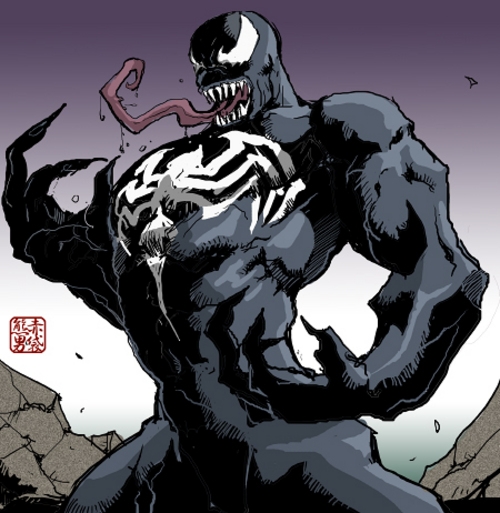
Venom regularly refers to himself as “we,” indicating that Eddie and the symbiote are two separate entities, although they usually act as one. The symbiote has given Eddie its knowledge of Spider-Man’s secret identity, as well as the aforementioned immunity to Spidey’s Spider Senses. Having bonded with Spider-Man previously, Venom’s symbiote affords him many parallel powers, including super strength, agility, wall-crawling, and a facsimile of Spidey’s webbing. It also delivers limited shape-changing capabilities, such as the ability to change his appearance or form teeth or claws that can be used offensively, as well as healing capabilities and limited invulnerability (Venom is virtually bullet-proof). Since the symbiote enhances the natural strength of the host, and because Eddie Brock was almost an Olympic class weightlifter prior to bonding with the alien, Venom is actually quite a bit stronger than Spider-Man.
Other than a commitment to killing Spidey, there is one consistent theme in Venom’s career: protecting the innocent. Unlike most heroes, though, Venom seems relatively comfortable (if not gleefully enthusiastic) when it comes to using lethal force. An interesting quirk of Venom’s is that, when acting as a vigilante, he does not seem inclined to hunt criminals. He is much more concerned with protecting the victims of crime rather than punishing the guilty. Some combatants have used this against him, as they know he will let them escape in order to rescue an innocent.
Brock is an emotionally volatile guy, even without a symbiote enhancing his aggressive emotions. He is a borderline psychopath, prone to extremely violent mood swings. Being separated from his “other” actually seems to enhance his violent and brooding moods.
Eddie was married to Anne Weying, but she divorced him after the scandal that cost him his job at the Daily Globe and plunged him into a dangerous depression. Eddie remained devoted to Anne, to the point that he commanded the symbiote to join with her in order to save her life after being shot (seen in the Venom: Sinner Takes All limited series). The symbiote joined with her again on a later occasion, but both of these experiences proved too traumatic for her to deal with and she later committed suicide.
After learning that he had cancer, Eddie had an apparent religious awakening. Paradoxically, this led him to sell his symbiote to crime lord Don Fortunato, intending to donate the $100 million pay-off to charity before dying (as seen in Marvel Knights: Spider-Man #7, published in December 2004). The Don’s son, Angelo, became the second Venom for a brief period of time, but the symbiote fatally abandoned him when he proved unworthy.
Further distraught to hear this news, Brock unsuccessfully attempted suicide. He was last seen recovering in a hospital.
Moving on from Angelo Fortunato, the symbiote bonded with Macdonald “Mac” Gargan (seen in Marvel Knights: Spider-Man #9), who was formerly known as the Scorpion. Gargan, as the new Venom, recently became a member of the Thunderbolts, who hunted anti-Registration rebels during Civil War.
It has been reported that Eddie Brock will soon return as Venom in Sensational Spider-Man Vol. 2 #38.
So far, Venom has five different character cards in Vs. System.
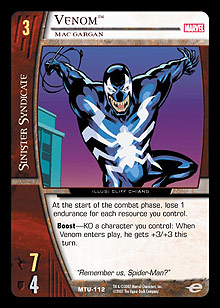 Venom, Mac Gargan is the smallest of these (a 3-drop) and appears on the Sinister Syndicate team in Marvel Team-Up. Straight away, you might have noticed that this is not Eddie Brock, who features in most of the above, but rather is the most recent incarnation of Venom, in which the symbiote has bonded with the former Scorpion, MacDonald Gargan. As fussy as I am, I’d normally like to see this card named Scorpion ◊ Venom, but in researching the character, I have learned that Gargan retains very little of his original personality and is almost completely controlled by the symbiote while in the Venom persona. When the symbiote is dormant in his body, Gargan has expressed nausea and fear of the organism (as revealed in Thunderbolts #112). That adequately addresses my angst over the naming situation. In terms of flavor-appropriate card design, the Venom 3-drop is right on target. He’s a dangerous guy to have on your team, and while his 7 ATK makes him a great attacking asset, you have to feed him every turn (in this case it’s endurance). Even more flavorful, though, is the fact that you can “feed” another character to him to give him a hefty stat boost on the turn he comes into play. Venom loves to snack.
Venom, Mac Gargan is the smallest of these (a 3-drop) and appears on the Sinister Syndicate team in Marvel Team-Up. Straight away, you might have noticed that this is not Eddie Brock, who features in most of the above, but rather is the most recent incarnation of Venom, in which the symbiote has bonded with the former Scorpion, MacDonald Gargan. As fussy as I am, I’d normally like to see this card named Scorpion ◊ Venom, but in researching the character, I have learned that Gargan retains very little of his original personality and is almost completely controlled by the symbiote while in the Venom persona. When the symbiote is dormant in his body, Gargan has expressed nausea and fear of the organism (as revealed in Thunderbolts #112). That adequately addresses my angst over the naming situation. In terms of flavor-appropriate card design, the Venom 3-drop is right on target. He’s a dangerous guy to have on your team, and while his 7 ATK makes him a great attacking asset, you have to feed him every turn (in this case it’s endurance). Even more flavorful, though, is the fact that you can “feed” another character to him to give him a hefty stat boost on the turn he comes into play. Venom loves to snack.
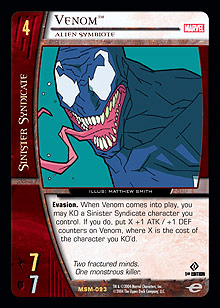 Venom, Alien Symbiote is a 4-drop Syndicate character from the Web of Spider-Man expansion. Once again, we see Venom chowing down on friendly characters and getting stronger as a result (with a permanent boost this time). I like to think of this as an early incarnation of Venom based on his recruitment cost and power. Brock seems wildly enthusiastic, reveling in the power the symbiote gives him. This version also has evasion, which represents the agility of the character—similar to that of Spider-Man.
Venom, Alien Symbiote is a 4-drop Syndicate character from the Web of Spider-Man expansion. Once again, we see Venom chowing down on friendly characters and getting stronger as a result (with a permanent boost this time). I like to think of this as an early incarnation of Venom based on his recruitment cost and power. Brock seems wildly enthusiastic, reveling in the power the symbiote gives him. This version also has evasion, which represents the agility of the character—similar to that of Spider-Man.
 Venom, Lethal Protector is a 5-drop from Marvel Team-Up, and perhaps surprisingly to some, is one of Spidey’s “friends.” This represents one of those occasions when Venom assisted Spider-Man, such as the aforementioned “Maximum Carnage” storyline. While the flavor text of this card talks tough, the Lethal Protector’s power is a lot less lethal than those on the other versions; you have to expect Eddie to tone it down if he’s going to run with Spidey! Aggressive stats mean that Venom is still a great ally to have in a fight, while evasion and an exhaustion-themed power gives him nice synergy with the other characters on the team.
Venom, Lethal Protector is a 5-drop from Marvel Team-Up, and perhaps surprisingly to some, is one of Spidey’s “friends.” This represents one of those occasions when Venom assisted Spider-Man, such as the aforementioned “Maximum Carnage” storyline. While the flavor text of this card talks tough, the Lethal Protector’s power is a lot less lethal than those on the other versions; you have to expect Eddie to tone it down if he’s going to run with Spidey! Aggressive stats mean that Venom is still a great ally to have in a fight, while evasion and an exhaustion-themed power gives him nice synergy with the other characters on the team.
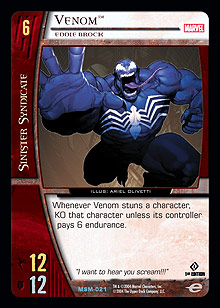 Venom, Eddie Brock is a 6-drop Sinister Syndicate character from Web of Spider-Man. He is one of my favorite characters. Period. Instead of killing your own characters, Eddie finally turns his sights on your opponent’s guys. If you tangle with Brock, it’s going to take a considerable endurance investment to stay out of the KO’d pile. No other version of Venom nails the flavor of the comic book character better, in my opinion.
Venom, Eddie Brock is a 6-drop Sinister Syndicate character from Web of Spider-Man. He is one of my favorite characters. Period. Instead of killing your own characters, Eddie finally turns his sights on your opponent’s guys. If you tangle with Brock, it’s going to take a considerable endurance investment to stay out of the KO’d pile. No other version of Venom nails the flavor of the comic book character better, in my opinion.
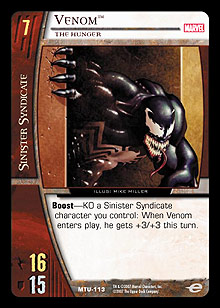 Venom, The Hunger is the biggest Venom on the block. He is a 7-drop Syndicate character from the Marvel Team-Up expansion. His boost effect is similar to the ones seen on other incarnations and again reflects his tendency to eat other characters. This version either comes from a four-issue miniseries of the same name published in 1996 or the Spectacular Spider-Man Vol. 2 #1-5 storyline from 2003 (or both). In the former, the symbiote developed a hunger for the previously mentioned brain chemical and indulged that craving. Brock was repulsed by this and rejected his other for a short period of time. Eddie was institutionalized, and the lone symbiote went on a killing spree. It ended with the pair being reunited, and it was established that Venom could get equivalent nourishment from chocolate. My favorite part of this card, though, is Mike Miller’s artwork, which I rate as the best for the character so far in Vs. System. Venom appears to be stalking, and the strain shown in him as he grips the wall suggests a powerful, uncontrollable hunger.
Venom, The Hunger is the biggest Venom on the block. He is a 7-drop Syndicate character from the Marvel Team-Up expansion. His boost effect is similar to the ones seen on other incarnations and again reflects his tendency to eat other characters. This version either comes from a four-issue miniseries of the same name published in 1996 or the Spectacular Spider-Man Vol. 2 #1-5 storyline from 2003 (or both). In the former, the symbiote developed a hunger for the previously mentioned brain chemical and indulged that craving. Brock was repulsed by this and rejected his other for a short period of time. Eddie was institutionalized, and the lone symbiote went on a killing spree. It ended with the pair being reunited, and it was established that Venom could get equivalent nourishment from chocolate. My favorite part of this card, though, is Mike Miller’s artwork, which I rate as the best for the character so far in Vs. System. Venom appears to be stalking, and the strain shown in him as he grips the wall suggests a powerful, uncontrollable hunger.
I think there is still a lot of fertile design space for future flavorful incarnations of Venom without even considering versions in which the symbiote is bonded with other hosts (like Anne Weying or Angelo Fortunato) or operating solo. I would love to see further exploration of the “Lethal Protector” tag, where his commitment to protecting the innocent can be highlighted.
With Venom featuring in the upcoming Spider-Man 3 film, the character is about to get a lot of mainstream exposure, so soon you might be able to wow a few non–comic reading, non–Vs. System playing civilians with your secret knowledge of Venom’s history.
In conclusion, below is the requisite recommended reading list to further your Venom experiences:
- Secret Wars #8; Amazing Spider-Man Vol. 1 #252–259, #298–300, and #315–317; Fantastic Four #274; and Web of Spider-Man #1 – Origin and early appearances (republished in Spider-Man: Birth of Venom TPB and partially republished in Spider-Man Vs. Venom TPB)
- Amazing Spider-Man Vol. 1 #330–333 and #344–347 – Erik Larsen artwork (republished in Spider-Man: Venom Returns TPB)
- Venom: Lethal Protector #1–6 (1993) – First Venom limited series
- Amazing Spider-Man Vol. 1 #378–380, Spectacular Spider-Man Vol. 1 #201–203, Spider-Man #35–37, Spider-Man Unlimited #1–2, and Web of Spider-Man #101–103 (1993) – “Maximum Carnage” (republished in Spider-Man: Maximum Carnage TPB)
- Spectacular Spider-Man Vol. 2 #1-5 (2003) – “The Hunger” (republished in Spectacular Spider-Man Vol. 1: The Hunger TPB)
- Venom vs. Carnage #1–4 (2004) – Republished in Venom Vs. Carnage TPB
- Venom #14–18 (2004) – “Twist” (republished in Venom Vol. 3: Twist TPB)
- Marvel Knights Spider-Man #5–8 (2004) – “Venomous,” Angelo Fortunato as Venom (republished in Marvel Knights Spider-Man Vol. 2: Venomous TPB)
See you in the funny pages,
Michael Pittman
ikeebear@hotmail.com